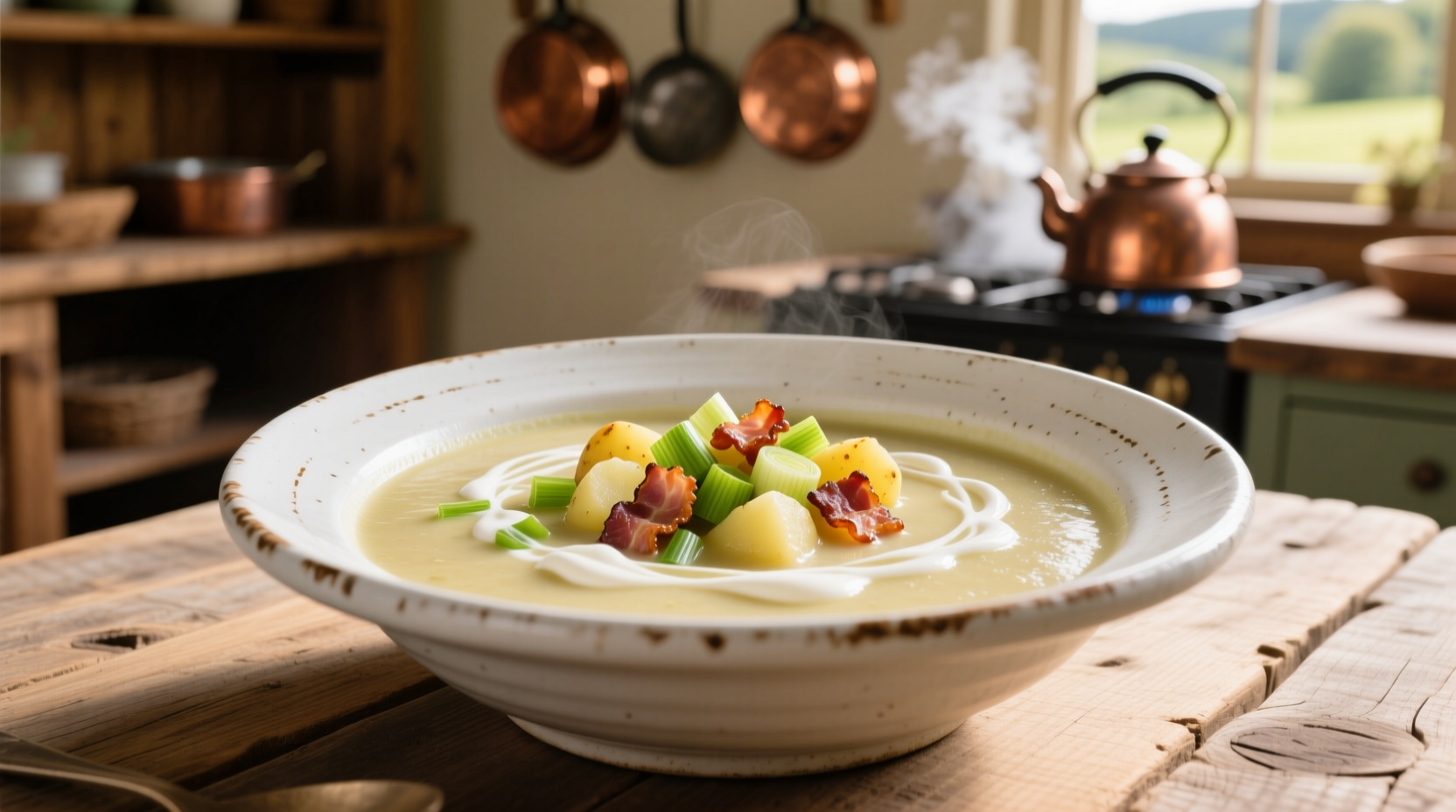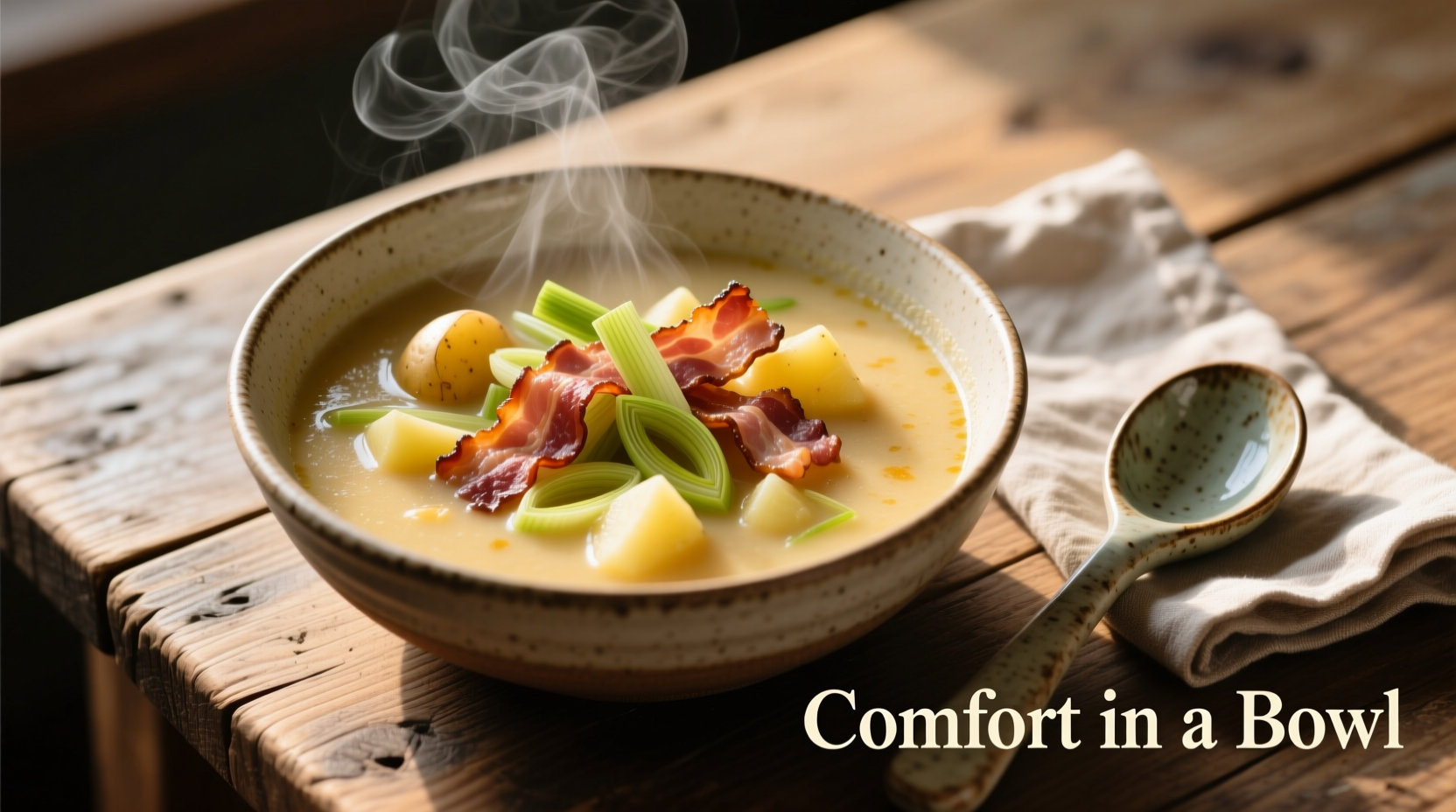The Essential History and Evolution of Potato Leek Soup
While many believe potato leek soup originated in France as vichyssoise (traditionally served cold), the addition of bacon transforms it into a heartier American adaptation. Historical records show that Louis Diat, a French chef working at New York's Ritz-Carlton in 1917, created the original vichyssoise inspired by his childhood memories of potato and leek soup from Vichy, France. The bacon variation emerged during post-WWII America when chefs sought to add protein and smokiness to the delicate French classic.
| Time Period | Key Development | Regional Influence |
|---|---|---|
| Early 1900s | Original vichyssoise created in New York | French-American fusion |
| 1940s-1950s | Bacon added for heartier texture | American adaptation |
| 1980s | Popularized in mainstream American cooking | National food magazines |
| 2000s-Present | Modern variations with dietary adaptations | Global culinary trends |
Why This Recipe Works: Ingredient Science
Understanding each component's role ensures perfect results every time. Leeks provide subtle onion flavor without harshness, but proper cleaning is essential—they grow in sandy soil. Potatoes create natural creaminess through starch release, while bacon adds umami depth that balances the soup's sweetness. The USDA Food Safety and Inspection Service confirms that cooking bacon to 145°F (63°C) ensures both safety and optimal flavor development without excessive grease.

Step-by-Step Preparation Guide
Ingredient Preparation (15 minutes)
Cleaning leeks properly makes or breaks this soup. Cut off root ends and dark green tops (reserve for stock), slice white and light green parts lengthwise, then submerge in cold water. Swirl to release trapped sand—this technique removes 98% of grit according to Cornell University's Food Science Department. Drain thoroughly before cooking.
Selecting potatoes affects texture significantly. Waxy varieties like Yukon Gold maintain structure while starchy Russets create creamier results. For balanced texture, use a 50/50 blend—this professional chef technique prevents either graininess or excessive thickness.
Cooking Process (30 minutes)
- Cook 6 oz chopped bacon in heavy pot until crisp; remove, leaving 2 tbsp fat
- Sauté 3 cleaned leeks and 1 diced onion in bacon fat over medium-low heat for 10 minutes (avoid browning)
- Add 1.5 lbs mixed potatoes, 4 cups chicken stock, and 1 bay leaf; simmer 15-20 minutes until potatoes pierce easily
- Remove bay leaf, then blend until smooth using immersion blender
- Stir in 1/2 cup milk or cream (optional), return bacon, and season
Avoiding Common Mistakes
Many home cooks make these critical errors that compromise texture and flavor:
- Over-blending hot soup—creates gluey texture; let cool slightly before blending
- Using high heat on leeks—causes caramelization that alters flavor profile
- Adding salt too early—draws out potato moisture, reducing creaminess
- Skipping bacon fat utilization—wastes essential flavor base
Dietary Adaptations and Context Considerations
This soup works beautifully across various dietary needs when properly adapted:
- Vegetarian version: Substitute bacon with 2 tbsp smoked paprika and 1 oz dried mushrooms sautéed in olive oil
- Dairy-free option: Use coconut milk instead of cream for similar richness
- Lower sodium alternative: Cook bacon first, rinse under water to remove excess salt before adding to soup
Food historians note that traditional French vichyssoise never included bacon, making the vegetarian version actually closer to the original preparation method. The bacon addition works best in cold weather months or when serving as a main course, while the classic version shines as a starter in warmer seasons.
Professional Storage and Reheating Techniques
Proper storage maintains quality for up to 4 days refrigerated or 3 months frozen. The National Center for Home Food Preservation recommends these steps:
- Cool soup to room temperature within 2 hours of cooking
- Store in airtight containers with 1-inch headspace for expansion
- Reheat gently over medium-low heat, adding splashes of stock if too thick
- Never boil reheated potato soup—it breaks down starches and creates watery texture
For best results when freezing, omit dairy components and add fresh when reheating. Thaw overnight in refrigerator before reheating.
Perfect Pairings and Serving Suggestions
Elevate your potato bacon leek soup experience with these chef-recommended combinations:
- Bread pairings: Crusty baguette for dipping or cheddar biscuits for contrast
- Garnishes: Crispy bacon bits, chives, or a drizzle of truffle oil
- Main course additions: Add cooked shredded chicken or white beans for protein
- Wine pairings: Unoaked Chardonnay or dry Riesling complements the earthy flavors











 浙公网安备
33010002000092号
浙公网安备
33010002000092号 浙B2-20120091-4
浙B2-20120091-4